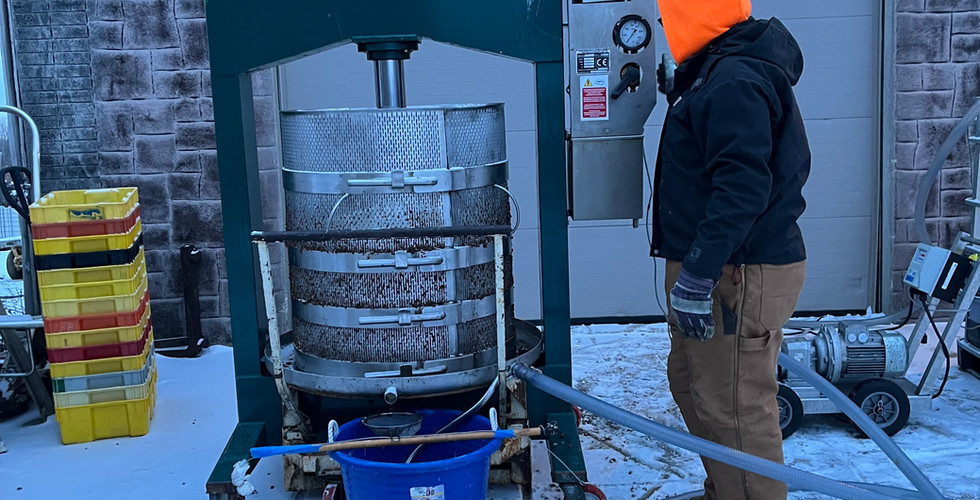Ice Wine Harvest in the Grand River Valley
- Lauren Fiala
- Jan 24, 2024
- 3 min read
Updated: Jan 27, 2024
History of ice wine is steeped in legend. Pliny the Elder wrote about wines being made from frozen grapes in Roman times. The first written accounts of ice wine dates to the late 18th century in the Rheingau, Germany. An early frost took place, and they made wine from frozen grapes as a way to save the vintage.
Ice Wine is considered heroic viticulture. To understand the depth of what that means you must understand the process. By law, grapes must freeze on the vine to be called ice wine. This requires “clean” grapes, meaning no rot or mold. Typically, grapes are harvested late August to late October in the northern hemisphere. Ice wine hangs on the vine for a significantly longer period. Since they are all that is left in the vineyards, they must be netted to avoid too much loss to wildlife.
In the United States we tend to follow the guidelines of Canadian Ice Wine picking. They wait until the temperature drops to 17°F. At this temperature water freezes but sugars, flavors and acids remain. Too much colder and you extract higher sugars, but you lose valuable yields. Higher sugars make it toxic for the yeast as well. Though there are a few vineyards that machine harvest, these grapes tend to be hand harvested. Imagine owning a winery that makes Ice Wine and it comes time to harvest. Staff, family and friends are called to come help in 17°F weather. To make this worse, this often occurs in the early morning. Volunteers are not often clamoring to go out and pick ice wine grapes in this type of weather.

Once picked they must be pressed frozen. This requires a press that creates high pressure. Traditionally basket presses have been favored, however membrane presses are becoming more important to this process. Once the juice is pressed and settled it must be heated to 60°F as the rest of the cellar is going through cold stability. Higher amount of yeast must be added to the juice. The yeast struggles to ferment Ice Wine. Typically speaking higher sugar means more alcohol but in this case, winemakers are lucky to ferment to 12% abv.
The Ice Wine from the 2023 growing season took place from January 14th to 17th , 2024 in the Grand River Valley, Ohio. This was one of the warmest Decembers on record, according to Nick Ferrante of Ferrante Winery. Despite the delay in the harvest date, this ended up being a larger crop than the previous vintage. The average picking temperatures were 4-6°F which created a situation where the grapes were too frozen to press, according to Gene Segel of South River Winery. He stated that this resulted in a longer, slower pressing. The Wineries press the Ice Wine in two or three passes. As the grapes are pressed the pomace compresses together to create a giant ice block. The wineries must break this mass apart and press it again. Each pressing they get slightly less sugar. Nick Ferrante said the first press yielded 45°Brix, the second 38°Brix, and third as 33°Brix. Ferrante picked 15 ton of Vidal Blanc for Ice Wine and it yielded 60 gallons per ton. Table grapes usually yield 150-175 gallons per ton.

Larry Laurello of Laurello Winery said every year they learn more about how to make Ice Wine. Each year you learn something new. When asked how much they picked he responded with a “sh*t load.” They had a smaller crop load last year due to winter injury. They left 28 rows of Vidal Blanc unharvested destined for Ice Wine. In typical years they will leave about 18 rows. Due to the bitter cold conditions on Wednesday they reached 52°brix of sugar in the first pressing! Larry mentioned they usually shoot for 36°Brix but that 39°Brix is ideal for Ice Wine juice. A specialty of Larry Laurello is his Ice Wine juice mixed with bourbon, it warms you right up and its delicious. A nice way to end a cold day of picking and pressing Ice Wine grapes!
This wine takes a lot of effort to make. There is a lot of loss along the way from grapes falling off the vine to animal damage. Then you loss more volume to water being trapped in the ice created. It is no wonder this wine is bottled in a 375 ml bottle instead of the normal 750ml. This is a lusciously sweet dessert wine. For reference, Coca Cola has about 100 g/l sugar compared to finished ice wine which has 150-250 g/l of sugar. Here in Ohio wineries are regularly winning awards for the amazing ice wines they make. I strongly feel that Ice Wine is one of the most special wines make here in Ohio.












תגובות